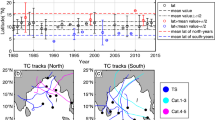Abstract
Tropical cyclones (TCs) are one of the natural disasters that draw significant damage to human society. This article aims to discover the potential environmental factors that lead to one of the most catastrophic tropical cyclone disasters ever recorded: the three continuous supertyphoon landfall in the Philippines in November 2006. The event is so unique because each year around 30 tropical cyclones are forming in the Northwestern Pacific Ocean Basin on average, but among which there were few precedent cases of 3 continuous Supertyphoons made their landfall one by one at the same location around a month, and environmental factors that drive such phenomenon require the combined interaction of many different environmental factors. Hence to discover these potential driving factors, the analysis will be conducted through discussing the observation in diversified aspects incorporating satellite data and previous researcher's idea. It is found out that in the oceanic aspect, both the El Niño Southern Oscillation (ENSO) phenomenon and the recovery effect from the salinity barrier can help sustain a relatively high sea surface temperature that energizes the development of the continuously occurred 3 STYs. On the other hand, the El Niño in 3CSTY's case, can increase both the intensity and the sustaining time of the TCs and shift the position of TCs southeastward. Considering the atmospheric conditions, it is revealed that the meso-scaled weather systems can affect TC’s development and generation location, and the CISK effect explains the role of low vertical wind shear plays in thermodynamic perspective.
Access this chapter
Tax calculation will be finalised at checkout
Purchases are for personal use only
Similar content being viewed by others
References
Chia HH (2002) The interannual variability in the genesis location of tropical cyclones in the Northwest Pacific
Demaria M (1996) the effect of vertical shear on tropical cyclone intensity change, Hurricane Research Division, NOAA/AOML
Gabriel AV, Brian JS (2007) Effect of remote sea surface temperature change on tropical cyclone potential intensity
Liou YA (2018) Season-dependent distributions and profiles of seven super-typhoons (2014) in the Northwestern Pacific ocean from satellite cloud images senior member. IEEE, Ji-Chyun Liu, Chung ** Liu, and Chung-Chih Liu
Pan J, Sun Y (2013) Estimate of ocean mixed layer deepening after a typhoon passage over the South China Sea by using satellite data
QuikSCAT/SeaWinds Scatterometer, National Environmental Satellite, Data, and Information Service, STAR Center for Satellite Applications and Research, 2005
Vialard J, Delecluse P (1998a) An OGCM study for the TOGA decade. Part I. Role of salinity in the physics of the western Pacific fresh pool. J Phys Oceanogr 28:1071–1088. Vialard J, Delecluse P (1998b) An OGCM study for the TOGA decade. Part II. Barrier-layer formation and variability. J Phys Oceanogr 28:1089–1105
Wang X, Hanc G, Qi Y, Li W (2011) Impact of barrier layer on typhoon-induced sea surface cooling. Dyn Atmos Oceans
Acknowledgements
In this research, I appreciate the academic support from the atmospheric and oceanic department of McGill University. Besides, the data from NOAA historical hurricane track website and WUNDERMAP (wunderground.com) which support the research by providing necessary TC information like wind speed, lifespan, and their tracks. Without which it is impossible to conduct a study on the environmental situation based on the atmospheric data at the time of 3CSTY presence. Besides, the research receives a contribution from QuikSCAT/SeaWinds Scatterometer as an indispensable satellite observed data resource in this study for analyzing the influence of meso-scaled air mass movement. This research also receives academic support from the atmospheric and oceanic department of McGill University.
Author information
Authors and Affiliations
Corresponding author
Editor information
Editors and Affiliations
Rights and permissions
Copyright information
© 2023 The Author(s), under exclusive license to Springer Nature Switzerland AG
About this paper
Cite this paper
Shi, K. (2023). Analysis of Environmental Factors of TC Intensification: A Case Study of Three Continuous Super Typhoons in November 2006. In: Zhang, J., Ruan, R., Bashir, M.J.K. (eds) Environmental Pollution Governance and Ecological Remediation Technology. ICEPG 2022. Environmental Science and Engineering. Springer, Cham. https://doi.org/10.1007/978-3-031-25284-6_2
Download citation
DOI: https://doi.org/10.1007/978-3-031-25284-6_2
Published:
Publisher Name: Springer, Cham
Print ISBN: 978-3-031-25283-9
Online ISBN: 978-3-031-25284-6
eBook Packages: Earth and Environmental ScienceEarth and Environmental Science (R0)



